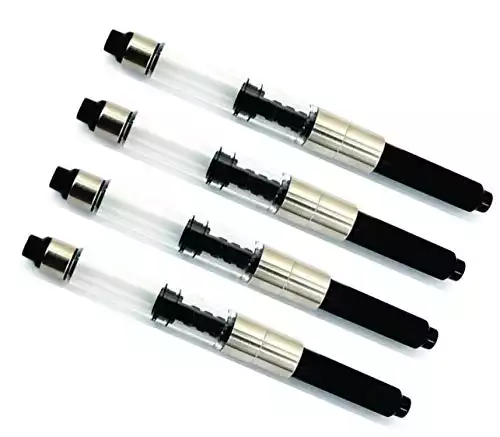Fountain pens can be…intimidating.
They were for me when I first started getting into them. Because they’re associated with fancy people and those dark smoky rooms, normies like you and me think we can’t use them.
Wrong.
Anyone can get a fountain pen and use the hell out of it.
So let’s get rid of some of these misconceptions and dig into some of your burning questions, like how to use a fountain pen, how to write with a fountain pen, and how to fill a fountain pen — plus some cleaning tips and FAQs.
Alright, let’s do this.
The anatomy of a fountain pen
To better understand how a fountain pen works, let’s dive deeper into its components, so everything doesn’t sound like gibberish when you start shopping.
Let’s start with the body of the pen.
But first, a pretty drawing to help you visualize these pen parts.
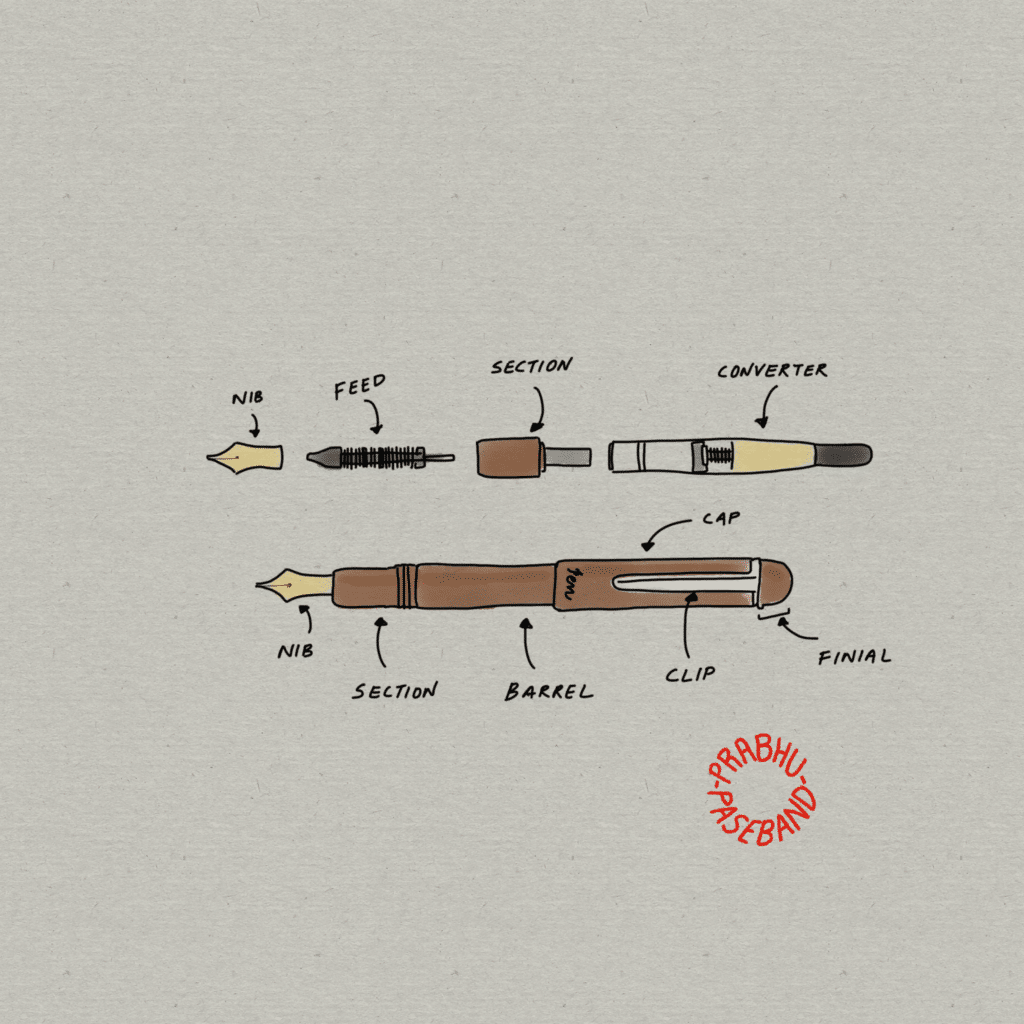
- Barrell. The barrel is the main body of the pen; it’s where the ink reservoir lives. It connects the grip section to the end of the pen or piston knob. Barrels can be made from various materials, including plastic, metal, or resin, and come in various colors and designs.
- Grip section. The grip section is where you hold the pen when you write. Its design, including shape, size, and material, is crucial in writing comfort and control. As you play around more with pens, you’ll find grips you prefer over others.
- Ink reservoir. The ink reservoir is the pen’s internal storage for ink. Depending on the type of fountain pen, the reservoir can be a piston chamber, cartridge, converter, or the barrel itself in the case of eyedropper pens.
- Cap. The cap protects the nib and feed when not using the pen. It can be a screw-on or snap-on design, often with a clip for attaching the pen to a pocket or notebook. Caps are made from materials similar to the barrel and may feature decorative elements like bands or engravings.
Next, let’s look at the nib.
Here’s another illustration.

- Nib. The nib is responsible for transferring ink to paper. It’s typically made of stainless steel and gold, but other metals are becoming popular. Nibs come in various sizes, from extra-fine to broad, and various styles which affect the line width of your writing.
- Tines. The tines are the two split parts of the nib that flex slightly when writing, allowing ink to flow. The space between the tines is called the slit, essential for proper ink flow.
- Breather hole. The breather hole helps regulate ink flow and allows air to enter the ink reservoir, replacing the ink as it’s used. The breather hole also provides structural support to the nib. It sits just above the slit.
- Feed. The feed sits below the nib and is typically made from plastic or hard rubber. It helps regulate ink flow from the reservoir to the nib. It has a series of fins and channels that control the flow of ink and balance air pressure inside the ink reservoir.
- Ink channel. The ink channel is a narrow groove within the feed that moves ink from the reservoir to the nib.
Ok, now you know about the body and the guts of fountain pens. Now let’s dig into how to use them.
How to write with a fountain pen
A pen is a pen, right? Not quite.
Writing with a fountain pen is different than writing with a ballpoint or gel pen. It takes a minute to adapt and get to used it. But once you do, you’ll find a much better writing experience.
Proper angle and pressure
Relax, we’re not going all in on math here. But, the angle you hold a fountain pen is important. If you don’t, you won’t get optimal ink flow and smooth writing.
Unlike ballpoint pens, fountain pens perform best when held at a 40-55° angle to the paper — basically the same angle you want to hold a glass bottle to get ketchup out of it. This angle allows the full width of the nib to make contact with the paper, ensuring consistent ink flow.
Now, the pressure.
When writing with a fountain pen, remember you need way less pressure than a ballpoint pen. Instead of pressing down, let the pen’s weight do the work. Applying too much pressure can bend the tines or cause scratchiness.
Practice angle and pressure to get the hang of it.
Positioning your hand and pen
A proper grip is essential for maintaining control and comfort while writing with a fountain pen. Position the pen between your thumb and index finger, allowing your middle finger to provide support from below.
Your thumb and index finger should rest on the grip section without squeezing too tightly.
Do not strangle your pen!
A relaxed grip improves writing fluidity and doesn’t give your hand cramps if you’re writing a lot at once.
Be mindful of the pen’s position relative to the paper. Incorrect positioning can result in scratchiness, ink flow problems, or difficulty writing.
Adapting writing techniques
Fountain pens offer a lot of versatility in writing styles due to the variety of nib sizes and shapes. You can experiment with different writing techniques, such as cursive, print, or calligraphy (just make sure you use the right ink).
Once you get comfortable with your pen, you’ll learn you can vary the angle and pressure while writing to achieve different line widths and ink flow.
For example, a flex nib can create line variation by applying more pressure on downstrokes and less on upstrokes, adding a bit of cool flair to your writing if you’re a fellow chicken-scratcher like me.
Practice and adapt your writing style to the specific characteristics of your pen. Some pens may require a lighter touch, while others may perform better with a slightly different angle.
Experimenting with different techniques will help you find the sweet spot that provides the best writing experience for you.
Ink and paper compatibility
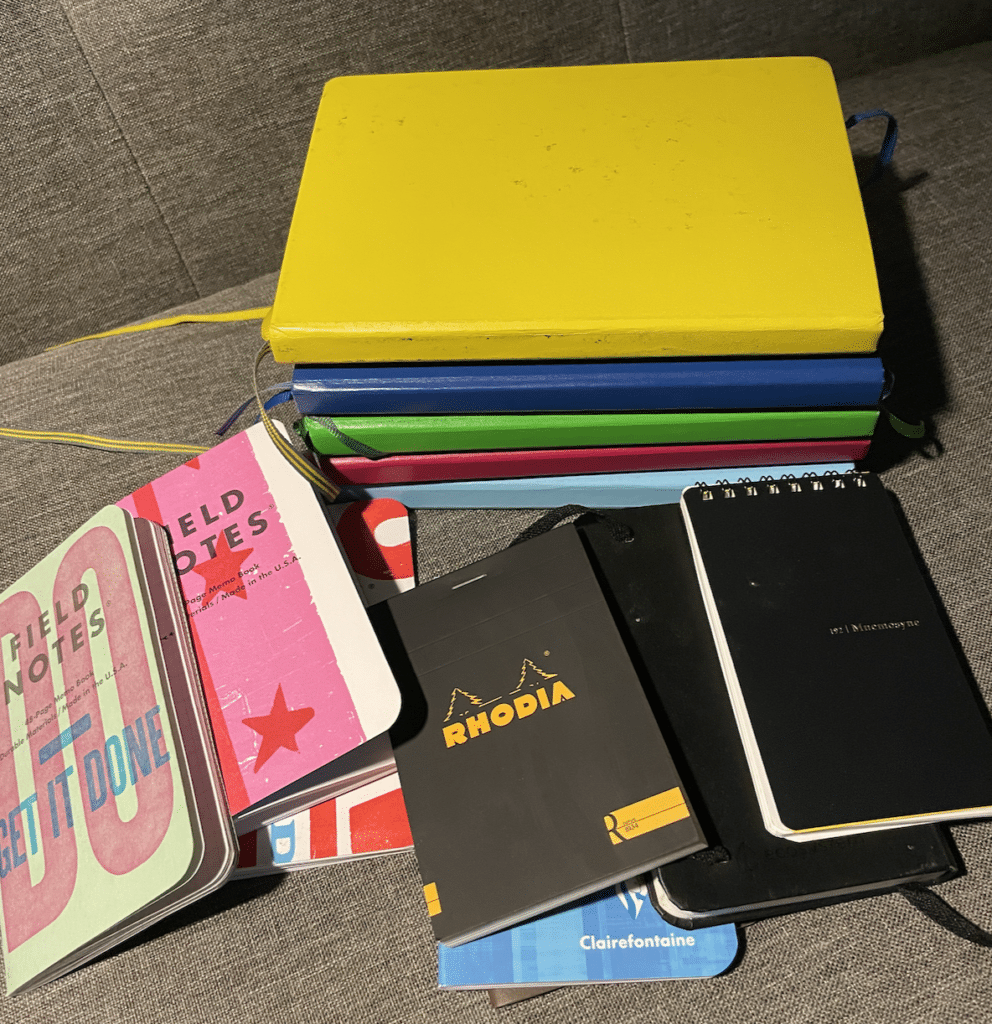
You can’t use any old paper for your fountain pen. Well, you can, but it may not look nice or bleed through. That’s why you want to make sure you look at notebooks that work well for fountain pens.
Some inks may flow better or dry faster, while others may provide more shading or sheen. Selecting an ink that complements your pen’s characteristics and your personal preferences is my favorite part of writing with a fountain pen.
The paper you choose can also impact how well your fountain pen performs. High-quality, smooth paper that resists feathering and bleed-through is ideal for fountain pen use.
Heavier paper with a higher GSM rating often works well with fountain pens, as it can better handle wetter ink without issues. GSM is basically the weight of the paper. The higher the GSM, the heavier the paper and the better it will handle fountain pen ink.
Download this cheatsheet and get expert solutions for the 13 most common pen problems.
Get The FREE CheatsheetHow to fill a fountain pan
Fountain pens come with a couple of different filling systems. But these are the most popular.
Filling a piston fountain pen with ink
A built-in piston mechanism within the pen’s barrel allows you to draw ink directly from an ink bottle into the pen’s internal reservoir.
How to fill a piston fountain pen:
- Unscrew the pen’s barrel to reveal the piston knob.
- Dip the nib into the ink bottle, ensuring it’s submerged up to the grip section.
- Twist the piston knob counterclockwise to extend the piston and expel any air from the pen.
- Twist the piston knob clockwise to retract the piston and draw ink into the reservoir.
Piston-filling pens may be a good choice if you want to frequently change inks or prefer a larger ink capacity for longer writing sessions. These pens tend to be a bit pricier because there are many moving parts inside to make them work.
Filling a cartridge or converter fountain pen with ink
Cartridge/converter fountain pens offer convenience and versatility. Personally, I tend to use a converter or cartridge to fill my fountain pens. They use pre-filled ink cartridges that snap into place or ink converters that let you use bottled ink.
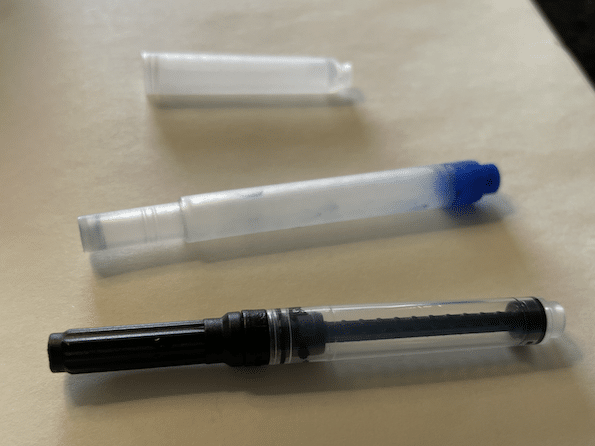
How to fill a cartridge or converter fountain pen:
- Unscrew the pen’s barrel and insert an ink cartridge or converter into the grip section.
- For a converter, dip the nib into the ink bottle and twist or push the plunger to draw ink in.
- Reassemble the pen and wait a few moments for the ink to flow to the nib.
Cartridge/converter pens are suitable for those who value convenience. They allow for easy ink changes and offer a more portable solution for on-the-go writing.
However, while cartridges are the easiest to use, you’ll also be most limited on ink. With converters, you can use any ink from a bottle. Check the type of converters that work with your pens. Some use universal converters, while others may be brand-only.
Filling an eyedropper fountain pen with ink
Eyedropper fountain pens have a simple design and a large ink capacity, as the entire barrel serves as the ink reservoir. These pens require an eyedropper or syringe to fill with ink.
How to fill an eyedropper fountain pen:
- Unscrew the grip section from the barrel.
- Fill the barrel with ink using an eyedropper or syringe, leaving some air at the top to avoid leaks.
- Apply a small amount of silicone grease to the threads of the grip section to create a seal.
- Screw the grip section back onto the barrel and wait for the ink to reach the nib.
Eyedropper pens are ideal for those who enjoy a minimalist design and a large ink capacity, but they may require more care to prevent leaks.
You may be able to adapt some cartridge or converter pens into eyedropper pens. I did it for my Jinhao Shark Pen, for example.
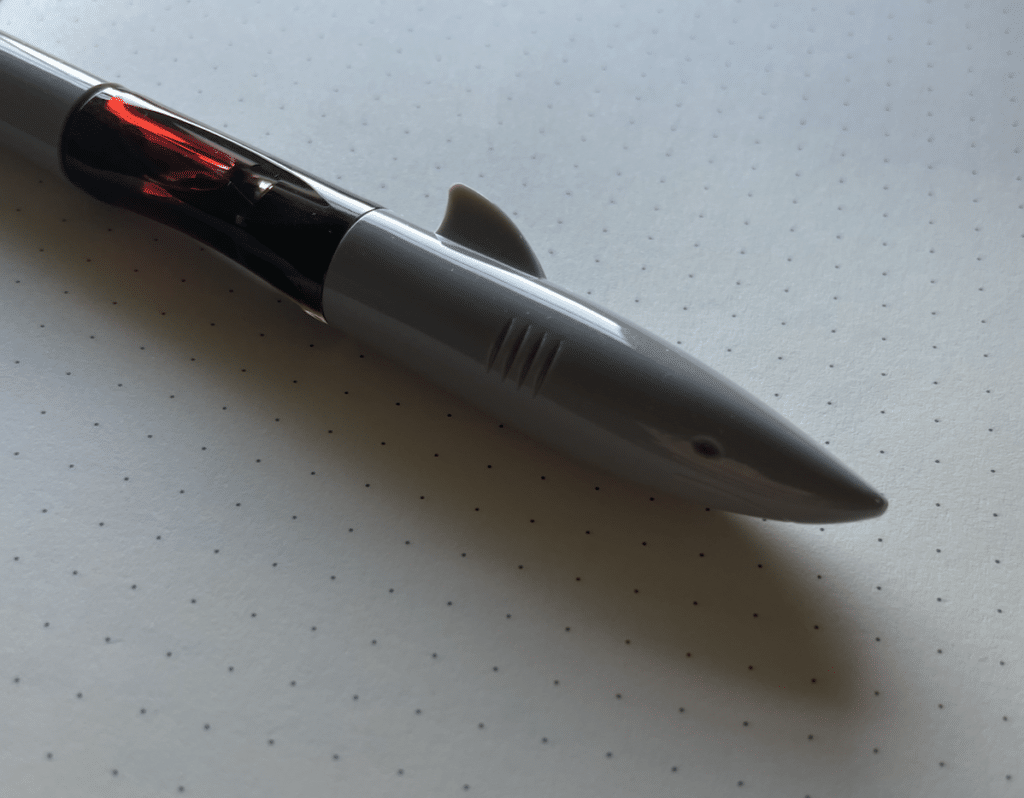
Each type of fountain pen caters to different preferences and needs. Understanding the differences in filling mechanisms and designs can help you select the pen that best suits your wish list and writing habits.
How to clean a fountain pen
To ensure your fountain pen lasts and writes well, you want to establish a proper cleaning and maintenance routine. As they say, an ounce of prevention is worth a pound of cure!
Regular cleaning
Cleaning your pen regularly is crucial to maintaining its performance and preventing issues like clogging or inconsistent ink flow. Otherwise, you’re going to get a crappy writing experience, and then what’s the point of having a fountain pen?
Taking care of your pen is pretty simple. You don’t need fancy gear; basic water does a great job.
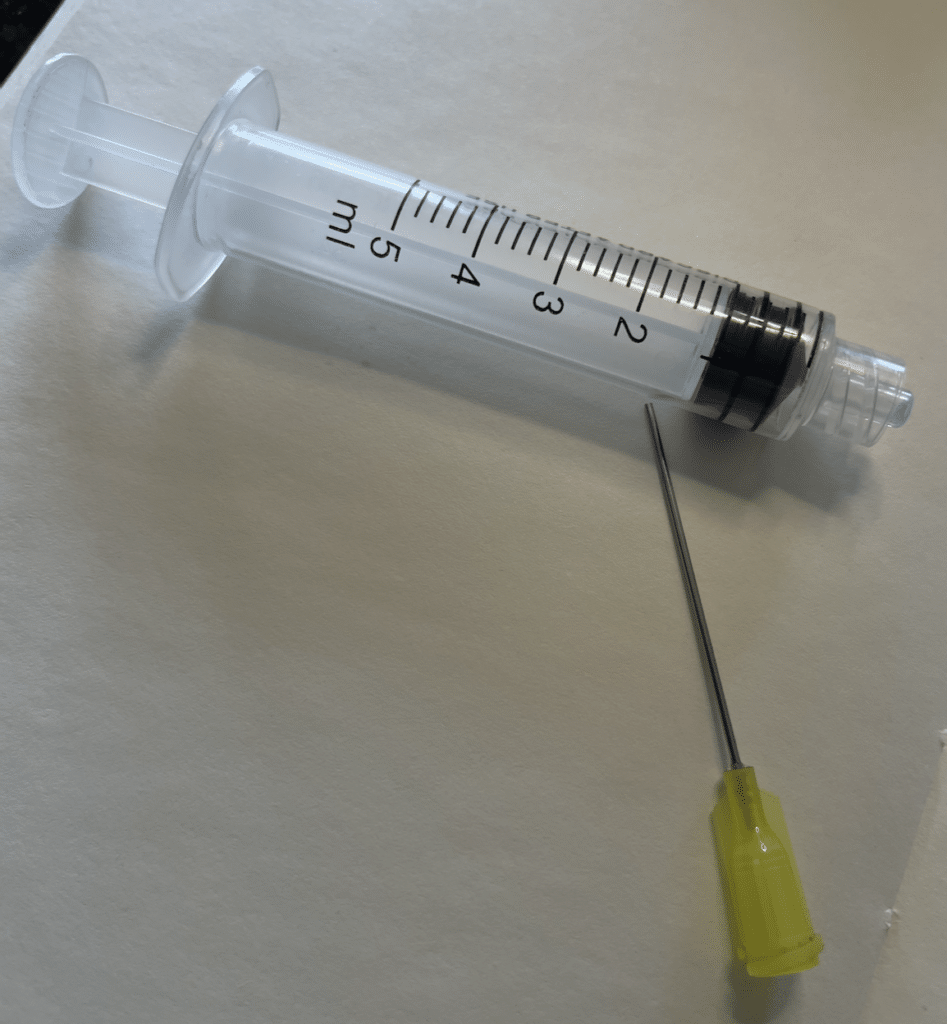
Here’s a step-by-step guide for how to clean your fountain pen:
- Disassemble the pen. Carefully remove the nib section, ink reservoir (cartridge, converter, or piston chamber), and barrel. This process may vary depending on your pen’s filling mechanism.
- Flush the nib section. Hold the nib section under room temperature water, allowing the water to flow through the feed and nib until it runs clear. You can also use a syringe to force water through the section more efficiently. Avoid hot water; it can damage the feed or other components.
- Clean the ink reservoir. If you have a converter or piston-filling pen, flush the ink reservoir with water until it’s clean. For cartridge pens, dispose of the used cartridge and replace it with a new one.
- Allow the pen to dry. Let the pen air dry thoroughly before reassembling and refilling it. You can gently shake the nib section to remove excess water and place it nib-down on a paper towel to help speed up the drying process.
If you don’t want to use water, you can spend a few bucks and get pen flush. It does a really good job of getting dried ink and gunk out of the nib and other moving parts.
Nib care
Taking proper care of the nib is essential for maintaining smooth writing and preventing issues like scratchiness or ink buildup.
Follow these guidelines for nib care:
- Clean after each use. Gently wipe the nib with a soft cloth or tissue after each use to remove any remaining ink or debris.
- Inspect the tines. Examine the tines periodically to ensure they are properly aligned. Misaligned tines can cause scratchiness or inconsistent ink flow.
- Adjust the tines gently. If the tines are misaligned, carefully adjust them using your fingers or a pair of tweezers. Be gentle, as excessive force may damage the nib or affect its performance.
If you’re finding a lot of scratching when you write, you can try to smooth the nib by using very fine micromesh sanding paper with 7,000-12,000 grit.
Be careful with this; a little bit goes a long way. Here’s a post on smoothing that may help.
Troubleshooting and preventive measures
If you experience issues with your fountain pen, such as skipping, ink flow problems, or scratchiness, it usually falls to one of a handful of potential problems.
Here are some common issues and their solutions:
Skipping
Skipping happens when the pen intermittently fails to lay down ink on the paper, causing gaps in your writing.
- Check the ink level. Low ink levels can cause skipping.
- Inspect the nib. Ensure that the tines are properly aligned and not damaged.
- Examine the feed. Check for dried ink or gunk that may be obstructing ink flow.
- Evaluate ink and paper compatibility. Certain ink and paper combinations may not work well together. Try using a different ink or paper to see if the issue persists.
Inconsistent ink flow
Inconsistent ink flow may result in writing that appears too light, too dark, or uneven — and looks like crap on the page.
- Inspect the tines. Misaligned or damaged tines can cause ink flow issues. Adjust or repair the tines if necessary.
- Check the ink reservoir. Ensure that the ink reservoir is properly seated and functioning. Clean or replace it if needed.
- Evaluate the ink. Some inks may be too thick or thin for your pen, causing flow problems. Try a different ink to see if the issue persists.
Scratchiness
Scratchiness is when the pen feels rough or catches on the paper while writing. You’ll know it when you feel it.
- Inspect the nib. Check the nib for any damage, such as bent or misaligned tines. Repair or replace the nib if needed.
- Check the nib’s smoothness. Use a magnifying glass to inspect the nib’s writing surface for rough spots or burrs. Smooth the nib using a nib smoothing kit, or consult a professional if you don’t want to do it yourself.
- Evaluate paper quality. Rough or textured paper may cause scratchiness. Try using a smoother paper to see if the issue persists.
Leaking
Leaking happens when ink escapes from the pen’s nib or barrel, causing messes and potential damage to the pen. Are you really a fountain pen enthusiast if you haven’t had ink all over your fingers at some point?
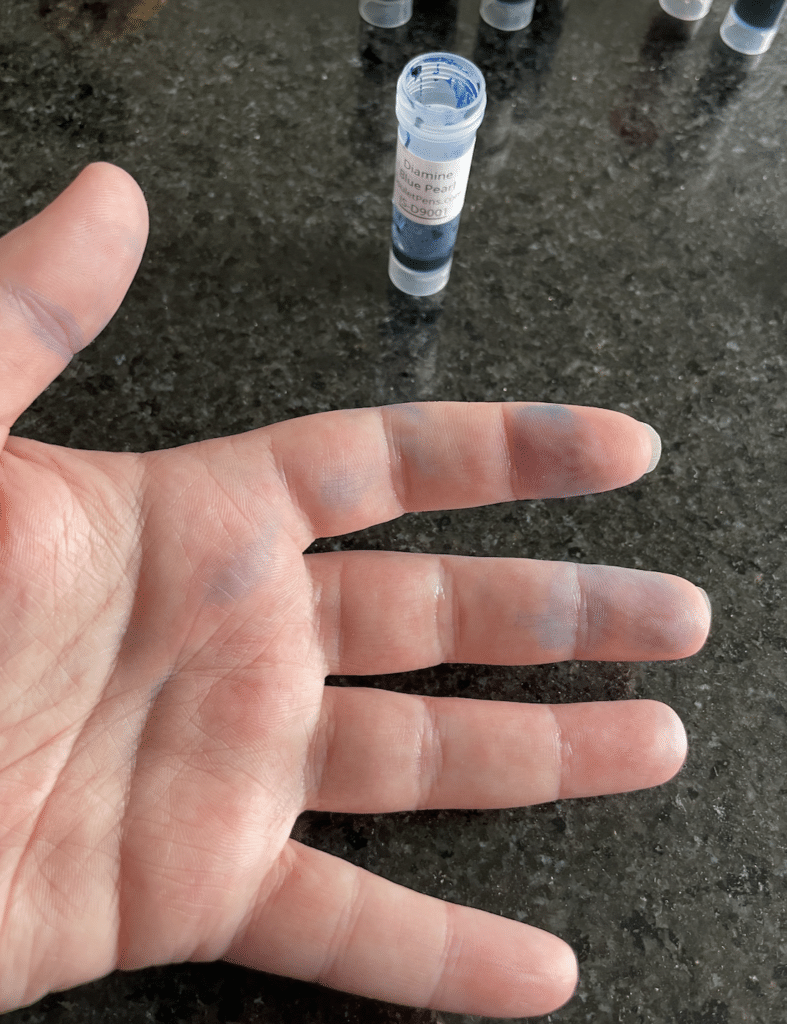
- Check the barrel and grip section. Ensure all parts of the pen are tightly connected and there are no cracks or damage to the pen’s body. If you made an eyedropper pen, try adding more silicone grease.
- Inspect the nib and feed. Make sure the nib and feed are properly seated and aligned.
- Check the ink reservoir. Look for any damage to the ink reservoir, such as cracks or leaks.
- Store the pen properly. When not in use, store the pen nib up to prevent ink leakage.
Regular maintenance and troubleshooting will help maintain the performance and longevity of your pen.
Fountain Pen FAQs
You may still have a few questions about how to use a fountain pen. Here are some of the most common.
- What is the best angle to hold a fountain pen while writing? The ideal angle for holding a fountain pen is 40-55° to the paper. This angle allows the nib’s full width to contact the paper, ensuring consistent ink flow.
- How often should I clean my fountain pen? You should clean your fountain pen at least once a month or whenever you change ink colors. Regular cleaning prevents ink buildup and clogging, ensuring a smooth writing experience.
- Can I use any ink in my fountain pen? Only use fountain pen-specific inks. They are formulated to work well with fountain pen feeds and nibs. Avoid India ink or calligraphy ink since they may clog or damage your pen.
- How do I know if my nib tines are misaligned? Misaligned tines can cause scratchiness, ink flow issues, or skipping. Check if they are properly aligned. If not, carefully adjust them using your fingers or a pair of tweezers.
- Why is my fountain pen leaking? Leaking can happen for several reasons, such as loose connections, damaged ink reservoirs, or improper storage. Check the barrel, grip section, nib, feed, and ink reservoir for any damage or loose parts, and store your pen nib up when not in use.
- Can I travel with my fountain pen? Sure, but be cautious when traveling by air since changes in cabin pressure can cause ink to leak from your pen. To minimize the risk, store your pen nib-up and either completely full or empty during your flight.
- What type of paper is best for fountain pens? High-quality, smooth paper that resists feathering and bleed-through is ideal for fountain pen use. Heavier paper with a higher GSM rating works well with fountain pens.
- Why is my fountain pen skipping? Skipping is usually caused by low ink levels, misaligned tines, dried ink or debris in the feed. Usually, cleaning your pen fixes a lot of issues.
- How do I replace the nib on my fountain pen? Check if your pen has a removable nib unit or a friction-fit nib. For a removable nib unit, unscrew and replace the old nib section. Pull the nib and feed out of the grip section for a friction-fit nib, then insert the new nib and feed.
- What is the difference between a flex nib and a standard nib? A flex nib allows for line variation by applying varying pressure while writing since the tines of a flex nib will spread apart when pressure is applied. Standard nibs don’t have significant line variation since the tines are stiffer and don’t spread as easily under pressure.
Enjoy your pen
Now that you know how to use a fountain pen, all the little bits and pieces that go with it, and got some answers to your most pressing questions, it’s time for the fun part.
Buying a pen.
So go out there with your newfound knowledge and start looking for your first fountain pen.
Liz
Hey, I'm Liz. I'm the founder of this thing. Pen-obsessed and a notebook nut, I love writing by hand. So I'm gonna talk about it on a computer.Download this cheatsheet and get expert solutions for the 13 most common pen problems.
Get The FREE Cheatsheet
